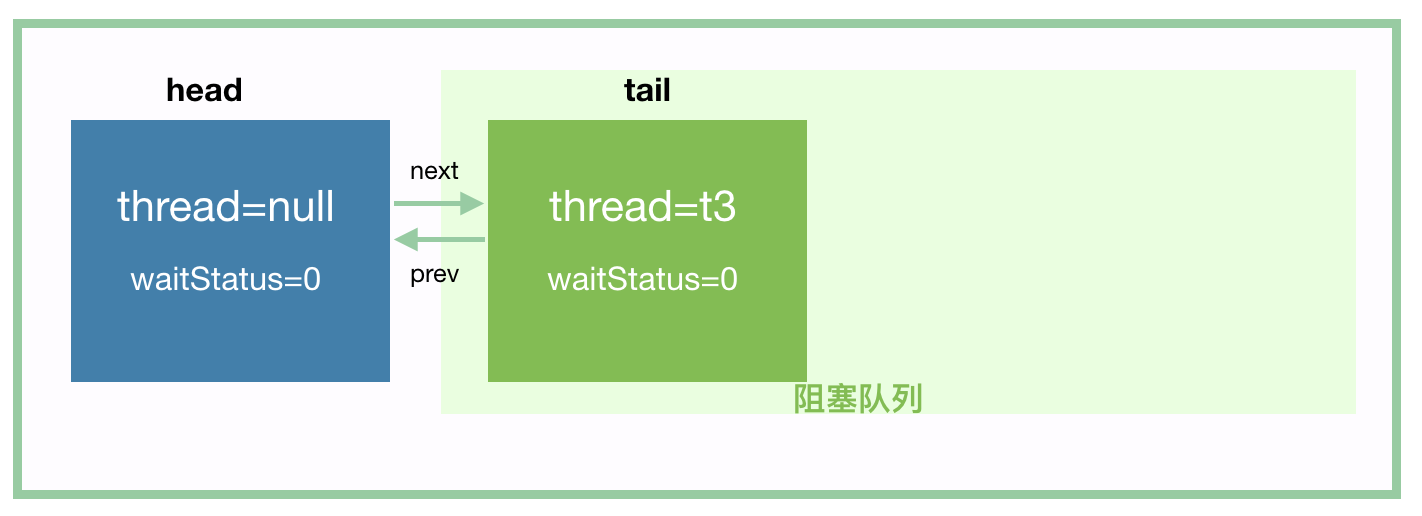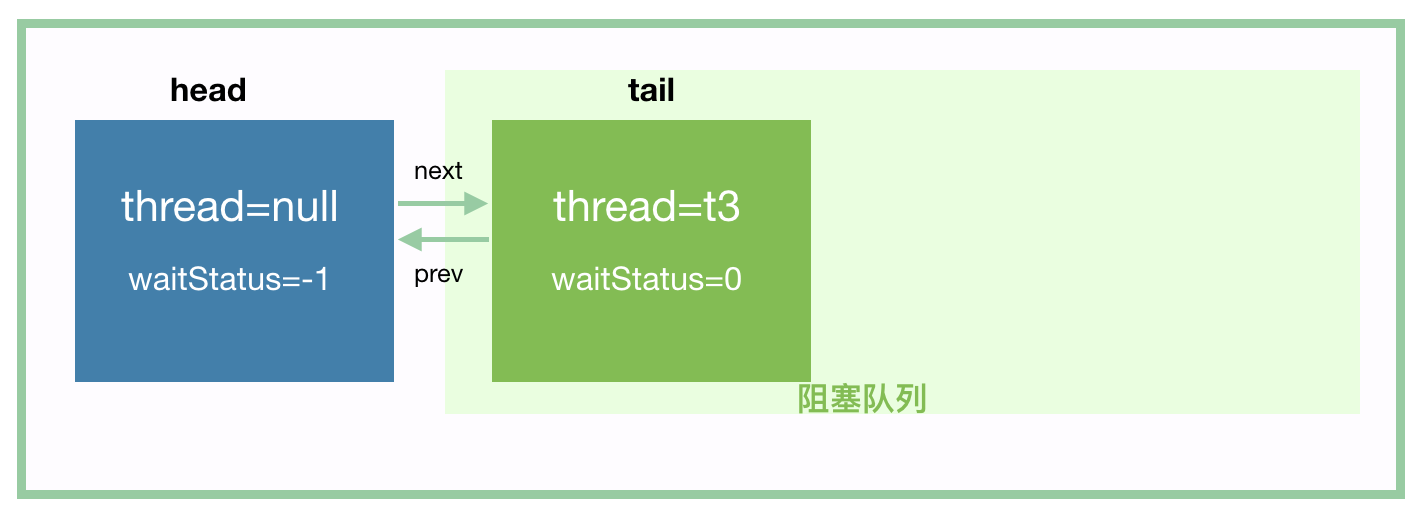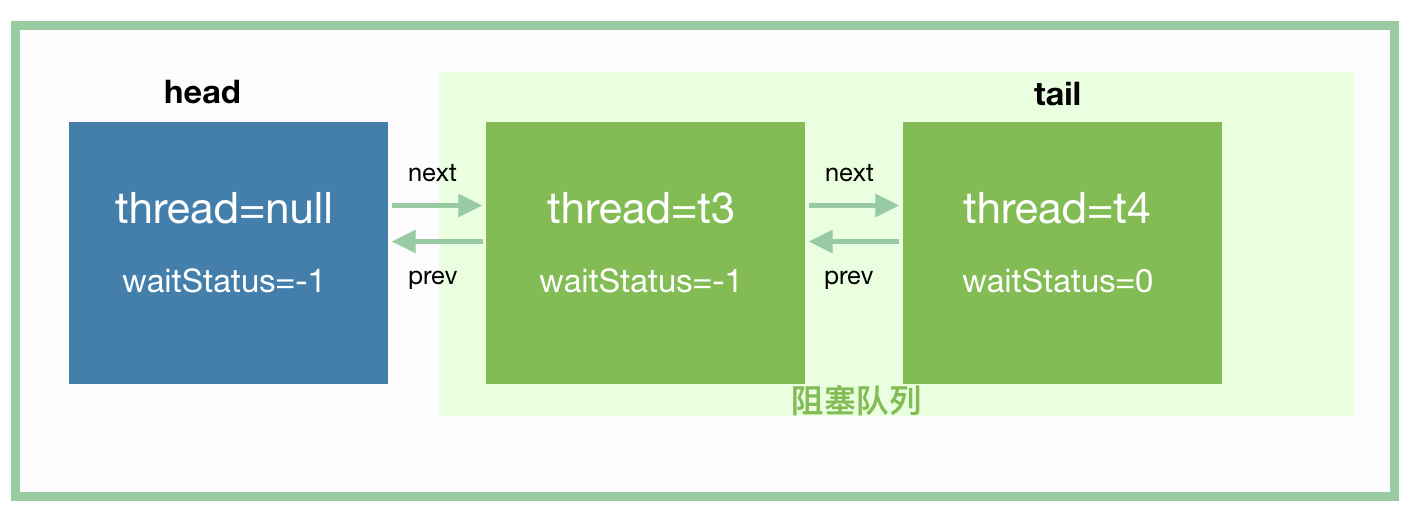CountDownLatch
Example:
1
2
3
4
5
6
7
8
9
10
11
12
13
14
15
16
17
18
19
20
21
22
23
24
25
26
27
28
29
30
31
32
33
34
class Driver2 { // ...
void main() throws InterruptedException {
CountDownLatch doneSignal = new CountDownLatch(N);
Executor e = Executors.newFixedThreadPool(8);
// 创建 N 个任务,提交给线程池来执行
for (int i = 0; i < N; ++i) // create and start threads
e.execute(new WorkerRunnable(doneSignal, i));
// 等待所有的任务完成,这个方法才会返回
doneSignal.await(); // wait for all to finish
}
}
class WorkerRunnable implements Runnable {
private final CountDownLatch doneSignal;
private final int i;
WorkerRunnable(CountDownLatch doneSignal, int i) {
this.doneSignal = doneSignal;
this.i = i;
}
public void run() {
try {
doWork(i);
// 这个线程的任务完成了,调用 countDown 方法
doneSignal.countDown();
} catch (InterruptedException ex) {
} // return;
}
void doWork() { ...}
}
example2:
1
2
3
4
5
6
7
8
9
10
11
12
13
14
15
16
17
18
19
20
21
22
23
24
25
26
27
28
29
30
31
32
33
34
35
36
37
38
39
40
class Driver { // ...
void main() throws InterruptedException {
CountDownLatch startSignal = new CountDownLatch(1);
CountDownLatch doneSignal = new CountDownLatch(N);
for (int i = 0; i < N; ++i) // create and start threads
new Thread(new Worker(startSignal, doneSignal)).start();
// 这边插入一些代码,确保上面的每个线程先启动起来,才执行下面的代码。
doSomethingElse(); // don't let run yet
// 因为这里 N == 1,所以,只要调用一次,那么所有的 await 方法都可以通过
startSignal.countDown(); // let all threads proceed
doSomethingElse();
// 等待所有任务结束
doneSignal.await(); // wait for all to finish
}
}
class Worker implements Runnable {
private final CountDownLatch startSignal;
private final CountDownLatch doneSignal;
Worker(CountDownLatch startSignal, CountDownLatch doneSignal) {
this.startSignal = startSignal;
this.doneSignal = doneSignal;
}
public void run() {
try {
// 为了让所有线程同时开始任务,我们让所有线程先阻塞在这里
// 等大家都准备好了,再打开这个门栓
startSignal.await();
doWork();
doneSignal.countDown();
} catch (InterruptedException ex) {
} // return;
}
void doWork() { ...}
}
这个例子中,doneSignal 同第一个例子的使用,我们说说这里的 startSignal。N 个新开启的线程都调用了startSignal.await() 进行阻塞等待,它们阻塞在栅栏上,只有当条件满足的时候(startSignal.countDown()),它们才能同时通过这个栅栏,目的是让所有的线程站在一个起跑线上。
 如果始终只有一个线程调用 await 方法等待任务完成,那么 CountDownLatch 就会简单很多,所以之后的源码分析读者一定要在脑海中构建出这么一个场景:有 m 个线程是做任务的,有 n 个线程在某个栅栏上等待这 m 个线程做完任务,直到所有 m 个任务完成后,n 个线程同时通过栅栏。
如果始终只有一个线程调用 await 方法等待任务完成,那么 CountDownLatch 就会简单很多,所以之后的源码分析读者一定要在脑海中构建出这么一个场景:有 m 个线程是做任务的,有 n 个线程在某个栅栏上等待这 m 个线程做完任务,直到所有 m 个任务完成后,n 个线程同时通过栅栏。
源码分析
构造方法
1
2
3
4
5
6
7
8
9
10
11
12
public CountDownLatch(int count) {
if (count < 0) throw new IllegalArgumentException("count < 0");
this.sync = new Sync(count);
}
// 老套路了,内部封装一个 Sync 类继承自 AQS
private static final class Sync extends AbstractQueuedSynchronizer {
Sync(int count) {
// 这样就 state == count 了
setState(count);
}
...
}
AQS 里面的 state 是一个整数值,这边用一个 int count 参数其实初始化就是设置了这个值,所有调用了 await 方法的等待线程会挂起,然后有其他一些线程会做 state = state - 1 操作,当 state 减到 0 的同时,那个将 state 减为 0 的线程会负责唤醒 所有调用了 await 方法的线程。
对于 CountDownLatch,我们仅仅需要关心两个方法,一个是 countDown() 方法,另一个是 await() 方法。
countDown() 方法每次调用都会将 state 减 1,直到 state 的值为 0;而 await 是一个阻塞方法,当 state 减为 0 的时候,await 方法才会返回。await 可以被多个线程调用,读者这个时候脑子里要有个图:所有调用了 await 方法的线程阻塞在 AQS 的阻塞队列中,等待条件满足(state == 0),将线程从队列中一个个唤醒过来。
1
2
3
4
5
6
7
8
9
10
11
12
13
14
15
16
17
18
19
20
21
22
23
24
25
26
27
28
29
30
31
32
33
34
35
36
37
38
39
40
41
42
43
44
45
46
47
48
49
50
51
52
53
54
55
56
57
58
59
60
61
62
63
64
public class CountDownLatchDemo {
public static void main(String[] args) {
CountDownLatch latch = new CountDownLatch(2);
Thread t1 = new Thread(new Runnable() {
@Override
public void run() {
try {
Thread.sleep(5000);
} catch (InterruptedException ignore) {
}
// 休息 5 秒后(模拟线程工作了 5 秒),调用 countDown()
latch.countDown();
}
}, "t1");
Thread t2 = new Thread(new Runnable() {
@Override
public void run() {
try {
Thread.sleep(10000);
} catch (InterruptedException ignore) {
}
// 休息 10 秒后(模拟线程工作了 10 秒),调用 countDown()
latch.countDown();
}
}, "t2");
t1.start();
t2.start();
Thread t3 = new Thread(new Runnable() {
@Override
public void run() {
try {
// 阻塞,等待 state 减为 0
latch.await();
System.out.println("线程 t3 从 await 中返回了");
} catch (InterruptedException e) {
System.out.println("线程 t3 await 被中断");
Thread.currentThread().interrupt();
}
}
}, "t3");
Thread t4 = new Thread(new Runnable() {
@Override
public void run() {
try {
// 阻塞,等待 state 减为 0
latch.await();
System.out.println("线程 t4 从 await 中返回了");
} catch (InterruptedException e) {
System.out.println("线程 t4 await 被中断");
Thread.currentThread().interrupt();
}
}
}, "t4");
t3.start();
t4.start();
}
}
await() 方法,它代表线程阻塞,等待 state 的值减为 0
1
2
3
4
5
6
7
8
9
10
11
12
13
14
15
16
17
18
public void await() throws InterruptedException {
sync.acquireSharedInterruptibly(1);
}
public final void acquireSharedInterruptibly(int arg)
throws InterruptedException {
// 这也是老套路了,我在第二篇的中断那一节说过了
if (Thread.interrupted())
throw new InterruptedException();
// t3 和 t4 调用 await 的时候,state 都大于 0(state 此时为 2)。
// 也就是说,这个 if 返回 true,然后往里看
if (tryAcquireShared(arg) < 0)
doAcquireSharedInterruptibly(arg);
}
// 只有当 state == 0 的时候,这个方法才会返回 1
protected int tryAcquireShared(int acquires) {
return (getState() == 0) ? 1 : -1;
}
从方法名我们就可以看出,这个方法是获取共享锁,并且此方法是可中断的(中断的时候抛出 InterruptedException 退出这个方法)。
1
2
3
4
5
6
7
8
9
10
11
12
13
14
15
16
17
18
19
20
21
22
23
24
25
26
27
28
29
private void doAcquireSharedInterruptibly(int arg)
throws InterruptedException {
// 1. 入队
final Node node = addWaiter(Node.SHARED);
boolean failed = true;
try {
for (;;) {
final Node p = node.predecessor();
if (p == head) {
// 同上,只要 state 不等于 0,那么这个方法返回 -1
int r = tryAcquireShared(arg);
if (r >= 0) {
setHeadAndPropagate(node, r);
p.next = null; // help GC
failed = false;
return;
}
}
// 2
if (shouldParkAfterFailedAcquire(p, node) &&
parkAndCheckInterrupt())
throw new InterruptedException();
}
} finally {
if (failed)
cancelAcquire(node);
}
}
我们来仔细分析这个方法,线程 t3 经过第 1 步 addWaiter 入队以后,我们应该可以得到这个:
 由于 tryAcquireShared 这个方法会返回 -1,所以 if (r >= 0) 这个分支不会进去。到 shouldParkAfterFailedAcquire 的时候,t3 将 head 的 waitStatus 值设置为 -1,如下:
由于 tryAcquireShared 这个方法会返回 -1,所以 if (r >= 0) 这个分支不会进去。到 shouldParkAfterFailedAcquire 的时候,t3 将 head 的 waitStatus 值设置为 -1,如下:
 然后进入到 parkAndCheckInterrupt 的时候,t3 挂起。
然后进入到 parkAndCheckInterrupt 的时候,t3 挂起。
我们再分析 t4 入队,t4 会将前驱节点 t3 所在节点的 waitStatus 设置为 -1,t4 入队后,应该是这样的:
 然后,t4 也挂起。接下来,t3 和 t4 就等待唤醒了。
然后,t4 也挂起。接下来,t3 和 t4 就等待唤醒了。
接下来,我们来看唤醒的流程。为了让下面的示意图更丰富些,我们假设用 10 初始化 CountDownLatch。

#### countDown() 方法
1
2
3
4
5
6
7
8
9
10
11
12
13
14
15
16
17
18
19
20
21
22
23
24
25
public void countDown() {
sync.releaseShared(1);
}
public final boolean releaseShared(int arg) {
// 只有当 state 减为 0 的时候,tryReleaseShared 才返回 true
// 否则只是简单的 state = state - 1 那么 countDown() 方法就结束了
// 将 state 减到 0 的那个操作才是最复杂的,继续往下吧
if (tryReleaseShared(arg)) {
// 唤醒 await 的线程
doReleaseShared();
return true;
}
return false;
}
// 这个方法很简单,用自旋的方法实现 state 减 1
protected boolean tryReleaseShared(int releases) {
for (;;) {
int c = getState();
if (c == 0)
return false;
int nextc = c-1;
if (compareAndSetState(c, nextc))
return nextc == 0;
}
}
countDown 方法就是每次调用都将 state 值减 1,如果 state 减到 0 了,那么就调用下面的方法进行唤醒阻塞队列中的线程:
1
2
3
4
5
6
7
8
9
10
11
12
13
14
15
16
17
18
19
20
21
22
23
24
25
// 调用这个方法的时候,state == 0
// 这个方法先不要看所有的代码,按照思路往下到我写注释的地方,我们先跑通一个流程,其他的之后还会仔细分析
private void doReleaseShared() {
for (;;) {
Node h = head;
if (h != null && h != tail) {
int ws = h.waitStatus;
// t3 入队的时候,已经将头节点的 waitStatus 设置为 Node.SIGNAL(-1) 了
if (ws == Node.SIGNAL) {
// 将 head 的 waitStatue 设置为 0
if (!compareAndSetWaitStatus(h, Node.SIGNAL, 0))
continue; // loop to recheck cases
// 就是这里,唤醒 head 的后继节点,也就是阻塞队列中的第一个节点
// 在这里,也就是唤醒 t3
unparkSuccessor(h);
}
else if (ws == 0 &&
!compareAndSetWaitStatus(h, 0, Node.PROPAGATE)) // todo
continue; // loop on failed CAS
}
if (h == head) // loop if head changed
break;
}
}
一旦 t3 被唤醒后,我们继续回到 await 的这段代码,parkAndCheckInterrupt 返回,我们先不考虑中断的情况:
1
2
3
4
5
6
7
8
9
10
11
12
13
14
15
16
17
18
19
20
21
22
23
24
25
26
27
private void doAcquireSharedInterruptibly(int arg)
throws InterruptedException {
final Node node = addWaiter(Node.SHARED);
boolean failed = true;
try {
for (;;) {
final Node p = node.predecessor();
if (p == head) {
int r = tryAcquireShared(arg);
if (r >= 0) {
setHeadAndPropagate(node, r); // 2. 这里是下一步
p.next = null; // help GC
failed = false;
return;
}
}
if (shouldParkAfterFailedAcquire(p, node) &&
// 1. 唤醒后这个方法返回
parkAndCheckInterrupt())
throw new InterruptedException();
}
} finally {
if (failed)
cancelAcquire(node);
}
}
接下来,t3 会进到 setHeadAndPropagate(node, r) 这个方法,先把 head 给占了,然后唤醒队列中其他的线程:
1
2
3
4
5
6
7
8
9
10
11
12
13
14
private void setHeadAndPropagate(Node node, int propagate) {
Node h = head; // Record old head for check below
setHead(node);
// 下面说的是,唤醒当前 node 之后的节点,即 t3 已经醒了,马上唤醒 t4
// 类似的,如果 t4 后面还有 t5,那么 t4 醒了以后,马上将 t5 给唤醒了
if (propagate > 0 || h == null || h.waitStatus < 0 ||
(h = head) == null || h.waitStatus < 0) {
Node s = node.next;
if (s == null || s.isShared())
// 又是这个方法,只是现在的 head 已经不是原来的空节点了,是 t3 的节点了
doReleaseShared();
}
}
又回到这个方法了,那么接下来,我们好好分析 doReleaseShared 这个方法,我们根据流程,头节点 head 此时是 t3 节点了:
1
2
3
4
5
6
7
8
9
10
11
12
13
14
15
16
17
18
19
20
21
22
23
24
25
26
27
28
29
30
31
32
// 调用这个方法的时候,state == 0
private void doReleaseShared() {
for (;;) {
Node h = head;
// 1. h == null: 说明阻塞队列为空
// 2. h == tail: 说明头结点可能是刚刚初始化的头节点,
// 或者是普通线程节点,但是此节点既然是头节点了,那么代表已经被唤醒了,阻塞队列没有其他节点了
// 所以这两种情况不需要进行唤醒后继节点
if (h != null && h != tail) {
int ws = h.waitStatus;
// t4 将头节点(此时是 t3)的 waitStatus 设置为 Node.SIGNAL(-1) 了
if (ws == Node.SIGNAL) {
// 这里 CAS 失败的场景请看下面的解读
if (!compareAndSetWaitStatus(h, Node.SIGNAL, 0))
continue; // loop to recheck cases
// 就是这里,唤醒 head 的后继节点,也就是阻塞队列中的第一个节点
// 在这里,也就是唤醒 t4
unparkSuccessor(h);
}
else if (ws == 0 &&
// 这个 CAS 失败的场景是:执行到这里的时候,刚好有一个节点入队,入队会将这个 ws 设置为 -1
!compareAndSetWaitStatus(h, 0, Node.PROPAGATE))
continue; // loop on failed CAS
}
// 如果到这里的时候,前面唤醒的线程已经占领了 head,那么再循环
// 否则,就是 head 没变,那么退出循环,
// 退出循环是不是意味着阻塞队列中的其他节点就不唤醒了?当然不是,唤醒的线程之后还是会调用这个方法的
if (h == head) // loop if head changed
break;
}
}
我们分析下最后一个 if 语句,然后才能解释第一个 CAS 为什么可能会失败:
- h == head:说明头节点还没有被刚刚用 unparkSuccessor 唤醒的线程(这里可以理解为 t4)占有,此时 break 退出循环。
- h != head:头节点被刚刚唤醒的线程(这里可以理解为 t4)占有,那么这里重新进入下一轮循环,唤醒下一个节点(这里是 t4 )。我们知道,等到 t4 被唤醒后,其实是会主动唤醒 t5、t6、t7…,那为什么这里要进行下一个循环来唤醒 t5 呢?我觉得是出于吞吐量的考虑。 满足上面的 2 的场景,那么我们就能知道为什么上面的 CAS 操作 compareAndSetWaitStatus(h, Node.SIGNAL, 0) 会失败了?
因为当前进行 for 循环的线程到这里的时候,可能刚刚唤醒的线程 t4 也刚刚好到这里了,那么就有可能 CAS 失败了。
for 循环第一轮的时候会唤醒 t4,t4 醒后会将自己设置为头节点,如果在 t4 设置头节点后,for 循环才跑到 if (h == head),那么此时会返回 false,for 循环会进入下一轮。t4 唤醒后也会进入到这个方法里面,那么 for 循环第二轮和 t4 就有可能在这个 CAS 相遇,那么就只会有一个成功了。